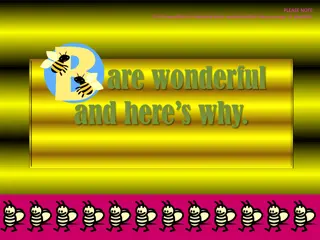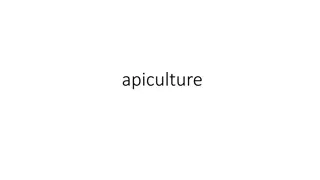Fascinating World of Bees: Bee Facts, Importance, and Beekeeping
Delve into the intriguing world of bees with facts about their behavior, importance in pollination, and the art of beekeeping. Discover how bees play a crucial role in our ecosystem, why humans rely on them for food production and oxygen, and the fascinating process of honey production.
Download Presentation

Please find below an Image/Link to download the presentation.
The content on the website is provided AS IS for your information and personal use only. It may not be sold, licensed, or shared on other websites without obtaining consent from the author.If you encounter any issues during the download, it is possible that the publisher has removed the file from their server.
You are allowed to download the files provided on this website for personal or commercial use, subject to the condition that they are used lawfully. All files are the property of their respective owners.
The content on the website is provided AS IS for your information and personal use only. It may not be sold, licensed, or shared on other websites without obtaining consent from the author.
E N D
Presentation Transcript
Un Un- -BEE BEE- -lievable Science Science lievable
What do you know about bees?
A bee beats its wings over 200 times per second True! That is one wing beat every 0.005 second
False. But a queen bee does lay 2500 eggs per A queen bee lays over 10,000 eggs per day day!
True. Honeybee, mason bee, carpenter bee, There are about 20,000 species of bees in the world blueberry bee, etc.
How does pollination work?
The fuzzier a bee is, the more pollen it can carry from plant to plant Plants need the pollen of other plants in order to produce seeds If bees disappear, plants will eventually disappear Humans need plants to survive They are an important part of our ecosystem
Why do humans need bees? Because humans need plants. Food Crops that are pollinated by bees are larger and better Oxygen Plants take in carbon dioxide and produce oxygen Water Plants clean water and help remove pollution
The Pollination Game!
How does beekeeping work?
How is honey made? 1. Bees collect nectar from plants by eating it They store it in an extra stomach called a crop 2. Bees return to the hive and throw up all the nectar Multiple bees eat and throw up the nectar, until it is partially digested and ready for the honey comb. 3. Bees use their wings to fan the watery nectar and speed up evaporation
4. Once the nectar is thicker, bees seal the honey comb with beeswax. 5. Stored this way, honey can last forever! 6. Bees store honey to eat over the winter months when there is no fresh nectar to harvest. 7. Bees usually make much more than they need, which is why humans can harvest honey after the winter.
What does honey taste like? Honey tastes sweet. But if you focus on the flavour, you might be able to guess where the nectar came from. For example, if the nectar came from peach trees, it has a slight peach flavour. If it came from wildflowers, it has a flowery flavour.
Bee Friendly to Bees
Bees like plants that are: Full of pollen and nectar Bright colours Especially blue, purple, white, and yellow Easy to land on Fragrant (the smellier the better!)
Yes! This is bee friendly. Yellow and easy to land on Sunflower
Yes! This is bee friendly. Purple and easy to land on Water Lily Has to be very attractive to bees so that they ll risk flying over the water
No! Not bee friendly. It eats bees! Venus Fly Trap
Yes! This is bee friendly. Bright and very fragrant Roses
Yes! This is bee friendly. Bright and easy to land on Very easy to find Dandelion
No! Not bee friendly. No pollen or nectar. Not bright. Fern
Yes! This is bee friendly. Bright and easy to land on Foxglove
Start your own bee garden























